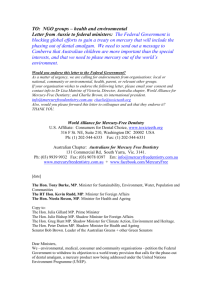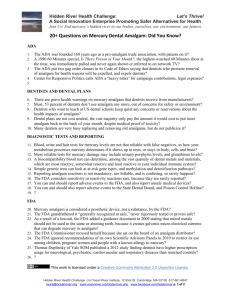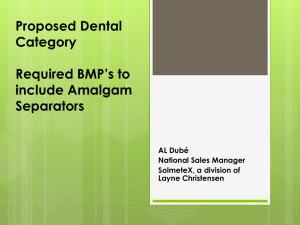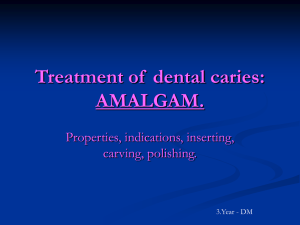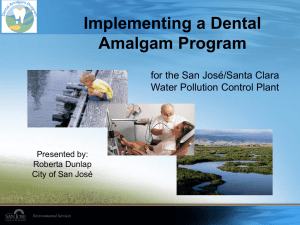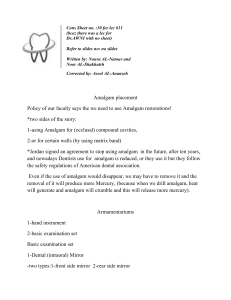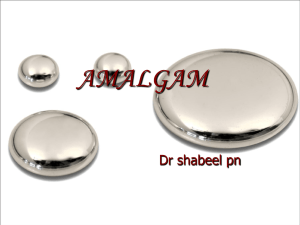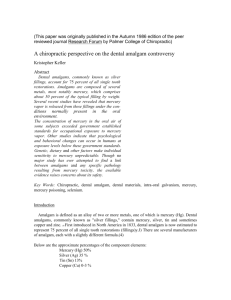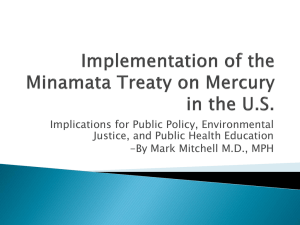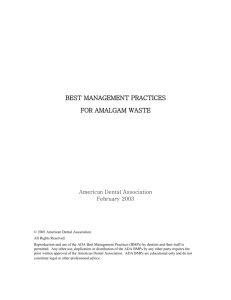NGO Perspective on Global Mercury Strategy and ASM Challenges
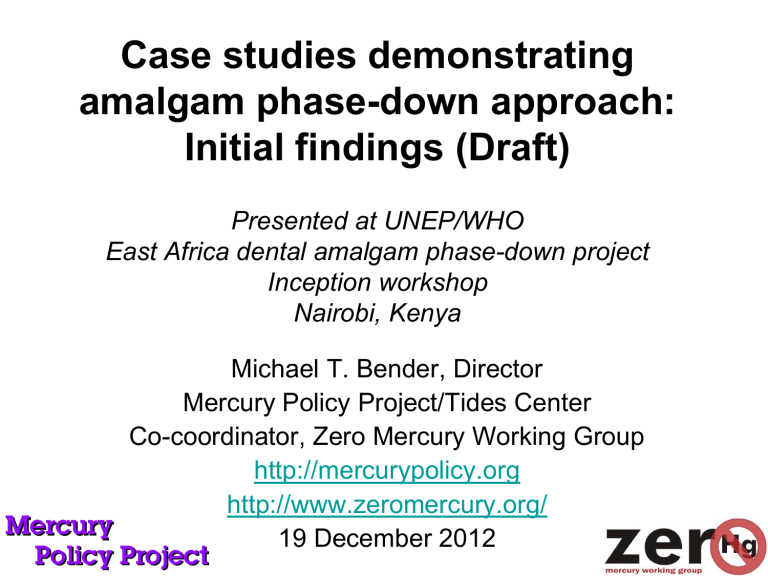
Case studies demonstrating amalgam phase-down approach:
Initial findings (Draft)
Presented at UNEP/WHO
East Africa dental amalgam phase-down project
Inception workshop
Nairobi, Kenya
Michael T. Bender, Director
Mercury Policy Project/Tides Center
Co-coordinator, Zero Mercury Working Group http://mercurypolicy.org
http://www.zeromercury.org/
19 December 2012
Mercury Policy Project &
Zero Mercury Working Group
• Mercury Policy Project was formed in 1998 to reduce mercury uses, releases and exposure to mercury at local, national and international levels
• The Zero Mercury Working Group is an international coalition of 94 public interest NGOs from 52 countries and was formed in 2005 to achieve ‘Zero’ emissions, demand and supply of mercury
Introduction - Background
• 2009 WHO meeting report supports dental amalgam phase-down
• Project builds on work of WHO and UNEP
• Seeks to contribute to East Africa project by presenting information from other country experiences with amalgam phase-down
• Preliminary findings reflect survey responses, also references country reports (1999; 2003;
2004;2005;2012) and EU BIOS report (2012)
Project goals & objectives
• Describe examples where countries have phased-down dental amalgam use
• Examine prevalent trends, variations and commonalities
• Provide information to governments on key elements of amalgam phase-down approach
• Assist countries in transitioning to mercury-free dental restorative materials
Survey questionnaire
• MPP consulted with UNEP and WHO in developing questionnaire
• Countries surveyed are those identified by
WHO and others with low amalgam use
• Responses received thus far from: Denmark,
Switzerland, Norway and Sweden; all were asked to review presentation
• Surveys also sent to Japan, Finland,
Vietnam, Russian, Singapore and Mongolia
Front page of survey questionnaire
“Substitution principle” approach
• All 4 countries follow the “substitution principle” with a policy use preference for least hazardous substance
• After years of voluntary reduction efforts, amalgam was phased-out in Norway in
January 2008 and in Sweden in June 2009
• In Norway, Hg amalgam use decreased from
840 kg in 1995 to near zero in 2008
• In Sweden, Hg amalgam use decreased from
980 kg in1997 to near zero in 2009.
*Courtesy of the EU Commission, BIO Intelligence
Service report, July, 2012, p.59
Denmark’s approach
• Decree that non-amalgam should be 1 st choice
• Amalgam banned in front teeth, but (as to be proposed in 2013) only be used when:
1. Not possible to keep area dry,
2. Difficult to access cavities,
3. A particularly large cavity, and
4 . There’s a great distance to proximate teeth
• Amalgam use in Denmark is now 5%
Switzerland’s approach
• Switzerland has “phased down” amalgam use to less than 10%
• 1989 Swiss Ordinance states that amalgam may not be used if mercuryfree product can be applied
• Amalgam usage dropped in Switzerland from 47% in 1996 to 12% in 2004
Controlling mercury releases to water
• Countries require BMPs, amalgam separators at new & existing clinics
• Separators average 70% removal capability
(although capable of >
95%) due to lack of maintenance in many cases
• Oversight includes periodic inspections, documentation of separator maintenance
Controlling mercury emissions to air
• Crematoriums major Hg emitter in many countries
• Responses indicate that between 44% to 100% of crematoriums have Hg control equipment
• In Switzerland, incinerators that burn sludge are equipped with flue gas cleaning devices that reduce Hg emissions
Awareness raising activities
• Information and regulatory programs raise awareness and reduce dental mercury release
• Awareness raising of mercury pollution in general, including campaigns for collecting discards, exposure reduction
• Bans on the import/export of mercury also have raised general public awareness
• Amalgam use in Swedish children was reduced from 30% in 1991 to 1.5% in 1995 & stopped after that.
• Amalgam use in Norwegian children was reduced by 90% between 1995 – 2002 and then was eliminated.
• Amalgam use in Danish children was banned in 2003
• As a precaution, Norway and
Sweden have advised pregnant women to avoid dental fillings
Precautionary principle
Dental school training
• Dental schools demonstrate efficacy of mercury-free alternatives
• Dental amalgam has not been used in Swedish dental schools for several years
• Denmark requires training of dentists in use of alternatives
• 2003 Norwegian guidance to practitioners to limit amalgam
“as much as possible”
Elements of a phase-down approach
• Preventative health care, (i.e. fluoride use)
• Countries follow substitution principle and precautionary principle
• Dental schools can play important role
• Elimination of subsidies for amalgam
• Awareness raising about environmental impacts, costs of managing mercury
• Consultations with stakeholders is key
Obstacles to amalgam phase-down
• Questions about performance and costs of nonamalgam fillings
• Objections from dentists not wanting to use new techniques, invest in new equipment, etc.
• Lack of skill may reduce the longevity of composites (sensitive to quality of intervention)
• Lack of awareness regarding benefits of ART
(Atraumatic Restorative Treatment)
• Impacts of environmental effects have not been fully demonstrated
• Negative externalities associated with amalgam use not factored into their cost
Summary: Country experiences with amalgam phase-down
• Overall, countries find no negative effects
• Initial investments required to control dental mercury releases, train dentists and for light curing equipment
• Larger composites may take longer to place but with training/experience, time decreases
• Net benefit of mercury use and release reductions over time
• For example, ability to use less contaminated sludge avoids higher disposal fees
